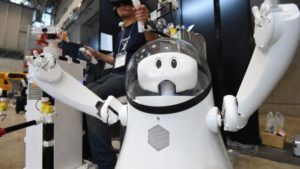Sep
28
2018
 I have long maintained that one of the greatest scientific questions for humanity is – are we alone in the universe? How common is life, and how common are alien technological civilizations? When we finally reach out into space, will it be empty for us to inhabit, or will we quickly encounter a galactic civilization? What will alien intelligent species be like, and what will that tell us about ourselves?
I have long maintained that one of the greatest scientific questions for humanity is – are we alone in the universe? How common is life, and how common are alien technological civilizations? When we finally reach out into space, will it be empty for us to inhabit, or will we quickly encounter a galactic civilization? What will alien intelligent species be like, and what will that tell us about ourselves?
It is unfortunately likely that we will not have any real answers to any of these questions anytime soon. But that does not mean we shouldn’t look. Recently NASA held a workup to explore possible avenues of looking for alien technosignatures – signs of advanced alien civilizations that we can see from Earth. Some of the participants also held a Reddit AMA.
So – what are alien technosignatures and how can we find them?
The most basic type is radio signals. There has been an effort to listen for alien radio signals for decades, often referred to as SETI, the Search for Extraterrestrial Intelligence. The idea is that radio signals are a convenient way to communicate across lightyears, and perhaps an alien world is sending out such signals for others to find. But really, we have been looking for radio signals because we can. It’s like the person looking for a lost item under a lamp post, not because they have any reason to find it there, but because the light is good.
Continue Reading »
Sep
27
2018
OK – this is my new favorite word: epistocracy. I first encountered it reading an article about attempts by the Indian government to control what passes for knowledge. It has the same root as “epistomology” – which is the philosophy of knowledge, or how to legitimately separate opinion from fact.
Epistocracy is essentially rule by the knowledegable. It is a relatively new term (the oldest reference I could find was from 2015), and replaces an older term, noocracy (dating from the 1930s). It refers to any system in which voting rights are restricted by some measure of intelligence or knowledge. The most recent advocacy for epistocracy was by Georgetown University political philosopher Jason Brennan, in his controversial book, Against Democracy.
The idea is that we already restrict voting rights, excluding those who are too young, are convicted felons (in some states), are mentally ill or cognitively impaired, or are naturalized citizens until they pass a civics test. So why have an arbitrary age cutoff, which is presumably to limit voting by citizens who are too young to have sufficient knowledge and judgment? Why not just test civic knowledge and let that be the criterion? Why should someone ignorant of politics have the same right to vote as someone who has invested the time and effort to reasonably understand the issues of the day?
To be clear – I think epistocracy is a horrible idea. I am not the first to point out that any such system would not only be ripe for abuse, it is practically a guarantee. Those in power could set the rules to favor those in power (they already do this – why make it easier). This would establish a self-reinforcing system of rule by a class of elites, with a patina of philosophical legitimacy.
In fact this has already been happening – from the moment, for example, that African Americans were given the right to vote, their political power was limited by epistocratic laws such as requiring literacy tests to register to vote. Voting rights legislation was required to strike down such laws.
Continue Reading »
Sep
25
2018
 The organic food lobby has been successfully demonizing safe and effective biotechnology for the last two decades. Part of their strategy is to create a false dichotomy between GMO (genetically modified organisms) and non-GMO. In reality there is a continuum of methods used to alter the genetics of crops that we have been using for centuries. There are real differences among these various techniques, but they do not divide cleanly into two categories (more on this below).
The organic food lobby has been successfully demonizing safe and effective biotechnology for the last two decades. Part of their strategy is to create a false dichotomy between GMO (genetically modified organisms) and non-GMO. In reality there is a continuum of methods used to alter the genetics of crops that we have been using for centuries. There are real differences among these various techniques, but they do not divide cleanly into two categories (more on this below).
The Non-GMO Project is part of this strategy. You have probably seen the labels, with the appealing butterfly reassuring consumers about the wholesomeness of products. Even when there are no GMO options for a food type, you can get the label. This scam makes money for the Non-GMO Project and is good for marketing. The goal is to eradicate any technology this non-expert and private group decides is GMO.
Now, the Information Technology and Innovation Foundation is hitting back. They are a non-profit science think tank whose purpose is to provide non-partisan science information to inform policy. They have submitted a petition to the FDA:
The Non-GMO Project food label deliberately deceives and misleads consumers in violation of the Federal Food, Drug and Cosmetic Act. ITIF petitions FDA to prohibit such labels. The “Non-GMO” Project butterfly logo and label on consumer foods and goods misleads and deceives consumers through false and misleading claims about foods, food ingredients and their characteristics related to health and safety, thus constituting misbranding under the law. ITIF therefore requests, in a Citizen’s Petition submitted to the Commissioner of Food and Drugs, that FDA issue a regulation to prohibit the use of the term “Non-GMO” on consumer foods and goods, and to require distributors of foods and goods to revise their labeling to omit any “Non-GMO” term, symbol, or claims.
This is essentially correct – one could argue that the purpose of the Non-GMO label is to confuse and misinform consumers, in order to extract more money out of them for equivalent or even inferior products.
Continue Reading »
Sep
24
2018
 Beginning 542 million years ago there was what scientists call the Cambrian Explosion. The name may be a bit misleading, because it is only an explosion in geological terms, taking tens of millions of years. This event refers to the geologically rapid appearance of many different phyla of multi-cellular creatures. All modern phyla (the taxonomic level just below kingdom) are represented in the Cambrian, along with many that did not survive to modern times.
Beginning 542 million years ago there was what scientists call the Cambrian Explosion. The name may be a bit misleading, because it is only an explosion in geological terms, taking tens of millions of years. This event refers to the geologically rapid appearance of many different phyla of multi-cellular creatures. All modern phyla (the taxonomic level just below kingdom) are represented in the Cambrian, along with many that did not survive to modern times.
The idea is that once multicellular life appeared, this new strategy was wildly evolutionarily successful, undergoing extreme adaptive radiation. Further, multicellular life evolved hard parts, like shells and bones, that fossilize well. The fossil record essentially turns on at this point, creating the impression of a rapid appearance of many species. However, there are fossils of older living organisms without hard parts, but they are more rare, requiring special conditions for their preservation.
One such pre-Cambrian group is called the Ediacaran fauna, from 571 to 541 million years ago. These are mostly large flat creatures, as if multicellular life had not yet worked out the trick of three-dimensionality. Getting oxygen to deep tissues requires specialized structures, not necessary for a flat organism. Scientists, however, did not know what the Ediacaran fauna were. Were they mats of fungi, or a failed dead-end branch of life wiped out the the more advanced three-dimensional Cambrian fauna? And if either of these two possibilities were true, then were are the precursors to the Ediacaran fauna? Their absence is not shocking, given that they would have been entirely soft creatures, but still, it would be nice to find some evidence of the lead up to the Cambrian.
Continue Reading »
Sep
21
2018
 You know, investigating can be difficult. There are many pitfalls, and it is easy to fool yourself, even when others are not trying to fool you. Critical thinking skills are indispensable to any investigative endeavor – along with specific domain knowledge.
You know, investigating can be difficult. There are many pitfalls, and it is easy to fool yourself, even when others are not trying to fool you. Critical thinking skills are indispensable to any investigative endeavor – along with specific domain knowledge.
Case in point – the mysterious case of the Croydon Cat Killer. For three years the mystery mutilator killed pet cats, eviscerated them, removed their heads and tails, and deposited the remains on display. Tabloids warned that the perpetrator would likely soon move onto humans. Veterinary pathologists and the metropolitan police were flummoxed. PETA offered a reward, and detectives from South Norwood Animal Rescue and Liberty (SNARL) found evidence of human involvement.
Investigators even worked up a profile of the likely suspect (40, male, problems with women, etc.).
Continue Reading »
Sep
20
2018
 In China, don’t criticize traditional Chinese medicine, that is, if you want to stay out of jail.
In China, don’t criticize traditional Chinese medicine, that is, if you want to stay out of jail.
Tan Qindong, an anaesthesiologist in Guangzhou, did what I and a lot of my SBM colleagues do – he wrote an article explaining to the public that a popular snake oil cure-all was – snake oil. For his troubles, he was jailed for almost 100 days, and forced to apologize. He had to admit that he was “not thinking clearly” when he defended science and the health of his patients against pseudoscience.
The company, Hongmao, not only filed the legal complaint but sued him in civil court. They then dropped their suit after Tan Qindong apologized.
Tan was jailed on an apparently seldom used law against damaging a company’s reputation. That would make consumer protection a little difficult in China. The government, however, is increasing its crackdown on any criticism, or expression of civil rights.
For example, Zhou Shifeng, director of Beijing’s Fengrui law firm, was jailed for 7 years for his part in exposing the baby formula scandal. Two people were executed as scapegoats for the practice of adding melamine to baby formula to fool tests assessing the amount of protein in the formula. But the Chinese government doesn’t like activists, and is doing a thorough job of squelching any criticism, no matter how legitimate.
Continue Reading »
Sep
18
2018
 If you were a woodworker, or any craftsman or probably had any job, in the 13th century you didn’t have to worry that technological innovation would render your position obsolete. With the industrial revolution, and the technological revolutions since, there has been an increasing pace of turnover of the kinds of jobs needed in the workplace. We no longer need switchboard operators, and the need for carriage drivers has plummeted.
If you were a woodworker, or any craftsman or probably had any job, in the 13th century you didn’t have to worry that technological innovation would render your position obsolete. With the industrial revolution, and the technological revolutions since, there has been an increasing pace of turnover of the kinds of jobs needed in the workplace. We no longer need switchboard operators, and the need for carriage drivers has plummeted.
Technology and automation do displace jobs. Worries that robots are coming for our jobs is not new – remember that Twilight Zone episode from 1964 where the W.V. Whipple Manufacturing Co. automates the factory and lets off all the workers? Well here we are more than 50 years later and the unemployment rate is historically low.
There are several ways to measure this, one is the productivity per person, or per hour worked. To put this into perspective, between the year 1 and the year 1820, productivity per year per person increased from about $600 to $1200, essentially doubling in about 2000 years. Since 1820, however, productivity increased to $26,000 – by more than a factor of 20. In the 20th century, the economy has grown by a steady 2% per year. This continuous growth has only been the norm for the past 200 years, however.
The pace of increasing productivity is also increasing. This is largely due to automation, W.V. Whipple style. Machines are increasingly doing much of the repetitive manual labor, and workers using modern technology can simply produce more. It’s often easy to see how automation will displace jobs. Eventually, self-driving cars will displace the Uber drivers who displaced the taxi drivers.
Continue Reading »
Sep
17
2018
 A new study reviews hundreds of articles on several farming systems (dairy, beef, wheat, and rice) to compare different approaches to farming and their net effect on the environment. They conclude that intensive farming systems are the “least bad” option for providing the food we need. This is in line with previous studies showing that organic farming uses significantly more land than conventional farming.
A new study reviews hundreds of articles on several farming systems (dairy, beef, wheat, and rice) to compare different approaches to farming and their net effect on the environment. They conclude that intensive farming systems are the “least bad” option for providing the food we need. This is in line with previous studies showing that organic farming uses significantly more land than conventional farming.
Farming has a huge negative impact on the environment. There is no way around that basic fact – farmland displaces natural ecosystems and has significant externalities, such as water use, release of CO2 from the soil, and runoff of chemicals into the environment. Right now we are using 11% of all land on Earth for farming, which is most of the land that is reasonably suitable for farming. To meet the needs of a growing population, we may need to expand farmland, into less and less productive land, which would significantly increase the negative impact of farming on the environment.
Some previous studies compared different farming systems by measuring the impact they have on the land. But this type of analysis is misleading – the authors of the current study instead looked at the environmental impact for a given production of food. That is what really matters. They also looked at studies that measured externalities, as listed above. They found:
Their results from four major agricultural sectors suggest that, contrary to many people’s perceptions, more intensive agriculture that uses less land may also produce fewer pollutants, cause less soil loss and consume less water.
They found that organic dairy farming uses twice as much land as conventional farming, for example.
Continue Reading »
Sep
14
2018
 Apple recently announced two new health features of their Apple Watch – fall detection and heart monitoring. These are being sold as useful health measures, but there are concerns that this new technology may be more gimmicky than useful, and might actually be counterproductive.
Apple recently announced two new health features of their Apple Watch – fall detection and heart monitoring. These are being sold as useful health measures, but there are concerns that this new technology may be more gimmicky than useful, and might actually be counterproductive.
The first feature detects possibly dangerous falls. If the motion detector senses that the wearer has fallen to the ground, and then they don’t move for one minute, the watch will automatically call 911. This superficially sounds reasonable, but the concern is that the tech company has not adequately tested this feature in coordination with medical professionals.
Specifically – what is the sensitivity and specificity of this algorithm? How often will it detect an event that reasonably requires a call to 911, and how many false positives will it generate? How much will this overwhelm emergency services?
What is naive about this feature is the lack of appreciation for the fact that medical interventions need to be evaluated. Why, for example, one minute? That is a round number, but is that really the threshold where the true-positive to false-positive ratio is optimal, while avoiding dangerous delays if someone is really injured?
Also, what will be the net effect of this? Will the drain on resources actually cause more harm than benefit to the users? How will 911 call centers handle these calls? Will they be able to interpret them?
Continue Reading »
Sep
13
2018
 Hurricane Florence is about to hit the Carolinas, extending as far south as Georgia and north as Virginia. The storm peaked at a Category 4, but now as it approaches land has been downgraded to a Category 2 hurricane. Hurricanes generally gain power over the ocean, from the energy of water evaporating off the surface, and then lose power when they hit land.
Hurricane Florence is about to hit the Carolinas, extending as far south as Georgia and north as Virginia. The storm peaked at a Category 4, but now as it approaches land has been downgraded to a Category 2 hurricane. Hurricanes generally gain power over the ocean, from the energy of water evaporating off the surface, and then lose power when they hit land.
But this weakening does not mean that the storm is not dangerous. The category refers only to wind speeds, but there are other factors to consider. First, this is a very large storm. Also, it is slowing down, so may stall over the Carolinas. This means it can just sit there, dumping large amounts of water. The two dangers are storm surges and flooding. A storm surge is the rise in sea level above the normal high tide, caused by the wind. This can rapidly flood coastlines.
Flooding occurs when rivers overflow their banks and there is simply too much water too fast to be absorbed into the ground or flow back to the ocean. Flooding and storm surges actually cause most of the damage and deaths during large storms, not the wind itself.
Dramatic storms like Florence always seem to prompt fresh discussion about the effects of global warming and what we should be doing about it.
Here is a good summary by the Geophysical Fluid Dynamics Laboratory of the effects of AGW on tropical storms. Warming does not increase the number of storms, but it does increase the average intensity of storms and the amount of water they drop. Therefore, statistically we should be, and are, seeing more intense storms and more flooding.
Of course you cannot blame any single storm on AGW – it is a statistical effect.
Continue Reading »
 I have long maintained that one of the greatest scientific questions for humanity is – are we alone in the universe? How common is life, and how common are alien technological civilizations? When we finally reach out into space, will it be empty for us to inhabit, or will we quickly encounter a galactic civilization? What will alien intelligent species be like, and what will that tell us about ourselves?
I have long maintained that one of the greatest scientific questions for humanity is – are we alone in the universe? How common is life, and how common are alien technological civilizations? When we finally reach out into space, will it be empty for us to inhabit, or will we quickly encounter a galactic civilization? What will alien intelligent species be like, and what will that tell us about ourselves?
 The organic food lobby has been successfully demonizing safe and effective biotechnology for the last two decades. Part of their strategy is to create a false dichotomy between GMO (genetically modified organisms) and non-GMO. In reality there is a continuum of methods used to alter the genetics of crops that we have been using for centuries. There are real differences among these various techniques, but they do not divide cleanly into two categories (more on this below).
The organic food lobby has been successfully demonizing safe and effective biotechnology for the last two decades. Part of their strategy is to create a false dichotomy between GMO (genetically modified organisms) and non-GMO. In reality there is a continuum of methods used to alter the genetics of crops that we have been using for centuries. There are real differences among these various techniques, but they do not divide cleanly into two categories (more on this below). Beginning 542 million years ago there was what scientists call the
Beginning 542 million years ago there was what scientists call the You know, investigating can be difficult. There are many pitfalls, and it is easy to fool yourself, even when others are not trying to fool you. Critical thinking skills are indispensable to any investigative endeavor – along with specific domain knowledge.
You know, investigating can be difficult. There are many pitfalls, and it is easy to fool yourself, even when others are not trying to fool you. Critical thinking skills are indispensable to any investigative endeavor – along with specific domain knowledge. In China, don’t criticize traditional Chinese medicine, that is, if you want to stay out of jail.
In China, don’t criticize traditional Chinese medicine, that is, if you want to stay out of jail. If you were a woodworker, or any craftsman or probably had any job, in the 13th century you didn’t have to worry that technological innovation would render your position obsolete. With the industrial revolution, and the technological revolutions since, there has been an increasing pace of turnover of the kinds of jobs needed in the workplace. We no longer need switchboard operators, and the need for carriage drivers has plummeted.
If you were a woodworker, or any craftsman or probably had any job, in the 13th century you didn’t have to worry that technological innovation would render your position obsolete. With the industrial revolution, and the technological revolutions since, there has been an increasing pace of turnover of the kinds of jobs needed in the workplace. We no longer need switchboard operators, and the need for carriage drivers has plummeted. A
A  Apple recently announced
Apple recently announced  Hurricane Florence is about to hit the Carolinas, extending as far south as Georgia and north as Virginia. The storm
Hurricane Florence is about to hit the Carolinas, extending as far south as Georgia and north as Virginia. The storm 




